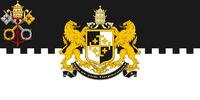Anti-Communism in Creeperopolis: Difference between revisions
No edit summary |
No edit summary |
||
| (5 intermediate revisions by the same user not shown) | |||
| Line 1: | Line 1: | ||
{{Romerism sidebar}} | {{Romerism sidebar}} | ||
'''Anti-Communism''' is an enforced policy '''in Creeperopolis'''. Creeperian Anti-Communism is an ideology and a political movement against Communism, as a theory and more specifically as it presented itself during the [[Second Parliament of Creeperopolis]] (1887-1933/1949). Organized Anti-Communism developed during the [[Creeperian Civil War]] with rise of the [[National Council | '''Anti-Communism''' is an enforced policy '''in Creeperopolis'''. Creeperian Anti-Communism is an ideology and a political movement against Communism, as a theory and more specifically as it presented itself during the [[Second Parliament of Creeperopolis]] (1887-1933/1949). Organized Anti-Communism developed during the [[Creeperian Civil War]] with rise of the [[National Council for Peace and Order]], nicknamed the ''Miguelists''. Anti-communism was one of the core elements of [[Romerism]] and the [[Catholic Imperial Restoration Council]], nicknamed the ''Romerists''. | ||
The first organization which was specifically dedicated to opposing communism was the [[ | The first organization which was specifically dedicated to opposing communism was the [[Creeperian Pro-Fatherland Front]] which fought in the [[Creeperian Civil War]] with its [[Camisas Negras]] starting in 1933 against the [[Creeperian Social Communist Party]] and its [[Atheist Red Army]]. The Romerist movement was militarily supported by several allied foreign governments which represented the first instance of Anti-Communism as a government policy in [[Creeperopolis]]. The Romerists defeated the Miguelists and Creeperopolis was stabilized in 1949. Following the civil war, the [[Creeperian Initiative]] was established with Anti-Communism as one of its core ideologies. | ||
The [[Creeperopolis|Creeperian Government]] continues to impose Anti-Communist policies. | The [[Creeperopolis|Creeperian Government]] continues to impose Anti-Communist policies. | ||
Diplomatic relations with [[Morova]] have been cut since 1920/1933. Supreme Leader [[Fyodor Ivanovich]] unexpectedly visited Creeperopolis in September 2019 following the arrest of a Morovan man possessing a pro-atheist communist pamphlet<ref>{{cite web|url=https://www.nationstates.net/page=rmb/postid=36335477|title=Morovan Man Arrested on Charges of Blasphemy and Atheism|date=September 2, 2019}}</ref>, marking the first time Morovan and Creeperian leaders met. The event has not been notified to the Creeperian public. | |||
The [[Third Senvarian Insurgency]] (1934- | The [[Third Senvarian Insurgency]] (1934-2020) against the separatist [[Senvarian Liberation Front]] was seen as an armed Anti-Communist struggle in Creeperopolis. A death squad, the [[Militarist Nationalist Front|Sombra Negra]], targeted [[Senvarians]] and communists since its establishment in 1940 by [[Adolfo Rivera López]] during the civil war. FRENAMI sees vigilante justice as the only way to cleanse Creeperopolis of communism. There are allegations that FRENAMI may be funded or operated by the Creeperian government, which denies the claims. | ||
= References = | = References = | ||
| Line 16: | Line 16: | ||
{{Creeperopolis topics}} | {{Creeperopolis topics}} | ||
{{ | {{El Salvador topics}} | ||
Latest revision as of 22:14, 26 February 2020
| Part of a series on |
| Romerism |
|---|
 Cross of Creeperopolis (symbol of Romerism) |
|
Anti-Communism is an enforced policy in Creeperopolis. Creeperian Anti-Communism is an ideology and a political movement against Communism, as a theory and more specifically as it presented itself during the Second Parliament of Creeperopolis (1887-1933/1949). Organized Anti-Communism developed during the Creeperian Civil War with rise of the National Council for Peace and Order, nicknamed the Miguelists. Anti-communism was one of the core elements of Romerism and the Catholic Imperial Restoration Council, nicknamed the Romerists.
The first organization which was specifically dedicated to opposing communism was the Creeperian Pro-Fatherland Front which fought in the Creeperian Civil War with its Camisas Negras starting in 1933 against the Creeperian Social Communist Party and its Atheist Red Army. The Romerist movement was militarily supported by several allied foreign governments which represented the first instance of Anti-Communism as a government policy in Creeperopolis. The Romerists defeated the Miguelists and Creeperopolis was stabilized in 1949. Following the civil war, the Creeperian Initiative was established with Anti-Communism as one of its core ideologies.
The Creeperian Government continues to impose Anti-Communist policies.
Diplomatic relations with Morova have been cut since 1920/1933. Supreme Leader Fyodor Ivanovich unexpectedly visited Creeperopolis in September 2019 following the arrest of a Morovan man possessing a pro-atheist communist pamphlet[1], marking the first time Morovan and Creeperian leaders met. The event has not been notified to the Creeperian public.
The Third Senvarian Insurgency (1934-2020) against the separatist Senvarian Liberation Front was seen as an armed Anti-Communist struggle in Creeperopolis. A death squad, the Sombra Negra, targeted Senvarians and communists since its establishment in 1940 by Adolfo Rivera López during the civil war. FRENAMI sees vigilante justice as the only way to cleanse Creeperopolis of communism. There are allegations that FRENAMI may be funded or operated by the Creeperian government, which denies the claims.
References
- ↑ "Morovan Man Arrested on Charges of Blasphemy and Atheism". September 2, 2019.
